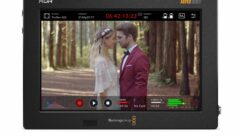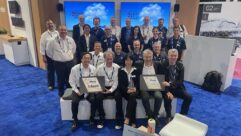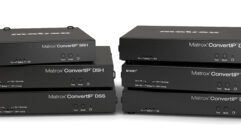Larger than Life: Furnishing video for large venues requires an acuteawareness of the available technology.
May 1, 1998 12:00 PM,
Peter H. Putman
A couple of years ago, I walked the floor at NAB ’96 with a companion fromthe corporate and broadcast video production industry. We wandered frombooth to booth, pausing now and then to check out the latest in desktopnon-linear video editing programs, cameras, recorders and special effectssoftware. “Wow, look at the quality of those images!” he exclaimed,pointing to a 27 inch (686 mm) presentation monitor demonstrating thelatest 3D imaging software. “Now, that’s video!”
A few minutes later, we strolled into the booth of a major manufacturer ofhigh-brightness video projection systems. Scenes from the latestshoot-em-up actionpicture were playing on a 12 foot (3.7 m) wide screen,projected by a three-CRT light valve projector using line doubling andaccompanied by Dolby surround audio. After observing my companion’sbug-eyed stare for several minutes, I nudged him in the shoulder andwhispered in his ear, “Now, that’s video!”
This sort of exchange happens all the time at major trade shows, wherefolks from the traditional broadcast and corporate video markets crosspaths with those of us who came up through the staging and rentalindustries. While our friends in the first market have mostly recorded,edited and played back composite or component video on 20 inch (508 mm)monitors, we’ve had to project everything from S-VHS to 1,280 x 1,024 fromdesktop and notebook computers, laserdisc, VCRs and even switched,live-camera coverage of meetings, on screens measuring 8 feet (2.4 m) to 20feet (6.1 m) and larger.
The world of large-venue video projection is the classic case of the tailwagging the dog. Because large-venue video images are so large anddetailed, all kinds of signal processing tricks are used to make them lookmore vivid and realistic. And, unlike our broadcast/desktop compatriots, wenot only have to know about NTSC signal processing, but must also bewell-versed in projection science, lighting and projection screentechnology.
Until a few years ago, large-venue video projection meant using a CRTprojector (or two or three) stacked carefully together for preciseregistration. But a new world of options opened up with the emergence offlat-screen and liquid-crystal displays, harnessed to super-bright arcprojection lamps. Now it was possible to project big 4 x 3 images withlight to spare, mixing Powerpoint and podium shots with equal aplomb.
Some producers and stage directors, limited by difficult projection throws,opted to use videowalls, made up of direct-view monitors or projectioncubes. Still others combined new and old technology to get out of the old4:3 box, harnessing the power of videowall controllers to drive two or moreCRT projectors in a seamless horizontal configuration and projecthigh-resolution panoramic video images.
The widespread use of video in everything from national sales meetings tobasketball tournaments has driven the large-screen display industry to newheights, both in technology and sales. As usual, the staging, rental andtheatrical companies using these products continue to push them to thelimits of their performance in the never-ending quest for brighter images,bigger images and more resolution. What can you expect from large-venuedisplay technology in 1998? Let’s take some time to see where the variousperformance “bars” are currently set:
Brightness The greatest progress in large-venue display technology has beenmade in image brightness. About 10 years ago, the only products that couldproduce 500 or more ANSI lumens were the Eidophor and GE Talariaprojectors. Today, most portable models can do better than that. Thanks tometal halide and xenon lamps, projectors with 1,000, 2,000, 3,000 and morelumens output are common.
The most important attribute of a life-like large venue image is itsgrayscale rendering, not sheer brightness. However, you need plenty ofhorsepower to achieve wide grayscales on large screens thanks to theinverse square law. In staging environments with high ambient light levels,blacks become dark grays (compressing the grayscale from the bottom), solight levels must be high to avoid compressing grayscales from the top aswell. In perfectly dark theater environments, there’s a bottom limit to thegrayscale, so insufficient light output still compresses grayscales fromthe top.
Here’s an example: A 300 lumen projector using a fixed-length,fixed-aperture lens may produce images of sufficient brightness at 10 feet(3.1 m). However, it will take 1,200 lumens to produce comparablebrightness at 20 feet (6.1 m), and nearly 5,000 lumens just to keep up at40 feet (12.2 m). Switching to a lens with a larger aperture helps, butthere’s still a two f-stop difference between the 10 foot and 20 footexamples. There’s a reason why light valve projectors and their lenses arebig.
Currently, all of the three-panel Barco light cannons can achieve at least1,000 to 1,500 ANSI lumens, with some models rated at 3,500 to 5,000lumens. Sony’s 800 series LCD projectors can produce 800 lumens, while theSony, Electrohome, and AmPro DLP designs chug along at 1,500 to 2,500 ANSI.NEC’s new MultiSync HiVid 3500 can crank out 3,500 ANSI lumens, whileDigital Projection’s Power 4dv and 5dv produce 3,500 and 5,000 lumens,respectively. Hughes-JVC’s 200 and 300 series projectors range from 2,000to 6,000 ANSI, with their Model 12K topping out at over 12,000 lumens.
All of these products easily clear the bar for fixed installations andstage applications for small groups with low to medium ambient lightlevels. Several of them have enough power to tackle long projection throwsand high ambient lighting as well.
Image quality The image quality bar is to achieve CRT-like white balanceand color rendering-not an easy task with flat-panel large venue displays.Short-arc, metal halide projection lamps solved one immediate problem(light output), but created another (colorimetry). Audiences loved thebright images, but noticed the large color shifts and greenish-blue whitescharacteristic of these lamps. While not as evident with Windows, Macintoshand other computer graphics, LCDs harnessed to metal-halide lamps produceda less than satisfactory image when projecting film-to-video transfers andlive video.
This problem was made worse when multiple projectors were used on adjacentscreens. No two projectors would produce the same white, making itdifficult to do panoramic or multi-image video projection. Barco, thelargest manufacturer of light valve projectors using TFT amorphous LCDimaging engines, has now turned its attention to taming the behavior ofmetal halide lamps. Internal circuitry is being developed to compensate forthe uneven spectral output, resulting in a color response closer to that ofCRT projection systems
Other manufacturers of light-valve projectors seeking better colorimetryhave opted to use Cermax and other styles of short-arc xenon lamps, whichhave a spectral response that is richer in reds, oranges and yellows.However, there’s a tradeoff-the light output of some xenon lamps can dropby a third after only a few hours of operation. Manufacturers includingDigital Projection, Hughes-JVC and NEC are all researching alternate xenonlamp technologies such as NEC’s proprietary bubble xenon arc lamp, which(it’s claimed) produces better than 80% of its rated light output after1,000 hours of operation.
Resolution Image resolution represents another bar to overcome on the wayto realism in large-venue displays. While the widespread adoption offlat-panel imaging systems (LCD, DLP) has brought plug-and-play operationto the highest levels of the industry, it has come with a price. That pricewas the noticeable pixel structure of the imaging panels.
Early amorphous LCD panels used in light valve projectors typically had 640x 480 or 750 x 480 pixel resolution, resulting in a screen-door effect thatis hard to miss even in today’s low-resolution LCD light valves. As fordigital light processing, the digital micromir-ror devices used incurrently available projectors have a finer resolution of 848 x 600 pixels,but the structure is still up there on the screen.
The average viewer can’t perceive line or pixel structures in displays oncethe vertical resolution exceeds 1,000 to 1,200 lines, so the logical answerfor all flat-panel technologies is to move up in resolution as quickly aspossible. Sony has reached SVGA (800 x 600) resolution in both LCD lightvalves and is working on 1,024 x 768 polysilicon engines, while Barcoemploys larger amorphous LCD panels with 1,024 x 768 and 1,280 x 1,024native resolution.
On the other hand, Hughes-JVC’s 2 inch (51 mm) image light amplifier (ILA)has no native resolution and is essentially limited by the resolution ofthe CRTs that drive it. Although the working resolution is specified to beabout 2,000 x 1,500 lines, it theoretically could be a lot higher. As forthe DLP marketplace, the next step is to move to Texas Instruments’ 1,024 x768 DMD imaging chips, and several XGA DLP projectors should be shippinglater this year. In essence, the resolution bar for light-valve projectorsin 1998 has been raised to at least XGA, with HDTV (1,920 x 1,080) loomingon the horizon.
Image size Theoretically, there’s no limit to how big an image can beprojected if the projector has enough light output. A decade ago, thelargest screen sizes used for staging and exhibits were usually 9′ x 12′(2.7 m x 3.7 m) or 10′ x 15′ (3.1 m x 4.6 m). Today, it’s not unusual tosee 20 foot (6.1 m) and wider screens in use simply because many projectorsare powerful enough to illuminate them with medium to long projectionthrows under both controlled-stage and high-ambient lighting conditions.
With the possible exception of the Hughes-JVC 12K, none of the existinglight-valve projection technologies is suitable for outdoor projectionunder broad daylight without supplementary shading. Direct sunlight canproduce in excess of 15,000 lux, whereas a cloudy, bright day will seereadings in the range of 3,000 to 5,000 lux. At present, only direct-viewdisplays like Sony’s JumboTron or transmissive-pixel systems likeMitsubishi’s DiamondVision can handle this environment.
Even so, light-valve projectors have been used outdoors successfully insuch large venues as outdoor stages and stadiums, usually at dusk or in theevening when ambient light levels can be better managed. It’s hard to saywhere exactly the image size bar is currently set, especially because thereare also mechanical and structural limitations to manufacturing super-sizedscreens. Suffice it to say that you can now achieve bright images withgrayscales exceeding 100:1 on screens up to 20 feet (6.1 m) wide withprojection throws up to 60 feet (18.3 m) using a single projector.
Videowalls The videowall industry has kept pace in its own way with theadvancements in projector technology, some of which have been incorporatedinto projection cubes. In terms of brightness, the larger cubes have eitheradopted flat-panel engines (again LCD and DLP) or moved to improved screencoatings for cubes using 7 inch (178 mm) CRTs.
Clarity Visual Systems has incorporated 640 x 480 polysilicon LCD panelsinto their 40 inch (1 m) and 52 inch (1.3 m) rear-projection cubes,claiming in excess of 200 foot-Lamberts of luminous energy. Synelec ofFrance has harnessed the DLP engine to a projection cube measuring 50inches (1.27 m) diagonally with slightly higher output. Both systems comeup a bit short to Pioneer’s RM-V2500NA and Toshiba’s P5031/32 series 50inch CRT projection cubes (each capable of over 400 foot-Lamberts). Lookfor further improvements in light output from both flat-panel technologies.
In terms of image quality, CRT projection cubes still have the upper handwhen it comes to matching the color of white on adjacent cubes. LCDprojection engines are somewhat limited by the use of metal-halideprojection light sources, although their color quality can be manipulatedwithin the three-panel LCD imaging system. Synelec’s DLP projection cubeuses the two-chip DMD engine, deriving red from a dichroic filter andblue/green from a color wheel, and its color quality is slightly morerestricted than the three-panel LCDs.
As far as resolution is concerned, only the Synelec LiteMaster cube has anative resolution higher than 480 vertical lines/pixels. It’s essentially adraw when deciding to stack CRT or flat-panel cubes, both of which requireoutboard signal processing to convert higher resolution (XGA, SXGA, HDTV)video and computer images down to their 31.5 kHz maximum horizontal scanrate. There are no plans to produce higher-resolution CRT cubes in the nearfuture, although Pioneer is experimenting with building videowalls fromtheir VGA (640 x 480) plasma display panels.
Two areas where there have been significant advancements in videowalls arein their footprints and screen sizes. Both Pioneer and Toshiba offer CRTprojection cubes that measure less than 30 inches (762 mm) in depth, whileboth the Clarity and Synelec cubes take up only 28 inches (711 mm).Electrosonic, Pioneer and Toshiba have also introduced pre-packaged 2 x 2cubes with 100 inch (2.5 m) diagonal image areas, and Toshiba has nowrolled out a 61 inch (1.5 m) diagonal cube as part of a 122 inch (3.1 m)wall package. None of these three systems occupies more than 30 inches (762mm), front to back.
For the videowall marketplace, the various bars are now projection cubesmeasuring at least 50 inches (1.3 m) with a 30 inch (762 mm) or smallerfootprint, VGA native resolution, four or more channels of digital signalprocessing and 200 or more foot-Lamberts of screen luminance. Perhaps themost significant change to look for this year will be the lowering of theprice bar as this market becomes more competitive.
Interfacing Interfacing is the last part of the large-screen video puzzle,and tremendous strides have been made in the way video and computer imagesare manipulated and displayed on these systems. Good thing, too-anyartifacts or noise introduced in the various transcoding, line multiplyingand color-detection processes will appear larger than life.
Every large-screen projection system and videowall processor available iscapable of handling video in its composite, Y/C component and YUV componentforms. Thanks to market demand for merging computer and video images, thereare a plethora of scan conversion and line multiplying products availablefor jumping between video and computer display resolutions, plus thedistribution amps and switching circuits needed to move these signals.
For example, line doublers were largely a novelty five years ago. Today,companies like Faroudja, Extron, IEV, Inline, Feral, NEC and PC VideoConversion offer line doublers, while Barco and Sony have come out withplug-in versions for their CRT projection systems. Line doublers havebecome quite popular in staging environments where a mixture of electronicpresentations and video is to be displayed. Instead of down-converting thecomputer images, they are processed straight through at 31.5 kHz or scanconverted to that frequency. Component video sources are switched upstream,processed as line-doubled signals, and subsequently fed to an RGB switcheralongside the computer data.
The next step? Probably a gradual move to line quadruplers and videoscalars. With quadruplers, full-frame NTSC video images are displayed with966 picture lines, while letter-boxed programming is boosted into the 550to 660 line area. Products such as Faroudja’s VP400 and Miranda’s Quartz doa very good job of interpolating the additional lines, resulting in imagesclose to film quality. Snell & Wilcox’s Supervisor and Interpolatorproducts accomplish a similar result by digitally re-scaling video to thesehigher resolutions.
Either way, operating in this high scan rate environment will be a bittricky because the signal carrying, processing and display equipment musthave significantly higher bandwidths. Cable lengths and characteristicimpedances become more critical. There’s nothing like signal attenuation,roll-off and ringing to ruin large-screen, high resolution video.
Looking ahead Where will the next bars be set? As usual, the resolution,bandwidth and even the design of projection engines will continue toadvance ahead of program sources and signal processing equipment. Oneexample of an unusual projection engine uses three colored lasers and ismanufactured by COLOR of Portsmouth, NH. Their Color Vision engine flattensa conventional laser beam to a thin line, then modulates it much like theelectron gun in a cathode-ray tube.
Currently, ColorVision images are limited to 9′ x 12′ (2.7 m x 3.7 m),although the company claims that 36 inch (914 mm) will be possible. At present, the system an accept signals with a maximum horizontal scan rate of 15.75kHz and a vertical refresh of 60 Hz (composite video) using proprietary D/Asignal processing. The solid-state lasers used produce in excess of 1,600coherent laser-lumens, which COLOR claims is bright enough for fully-litarenas, stadiums and exhibit halls.
Also look for an expansion of RGB switchers and distribution amps that willwork with both line-quadrupled/scaled video and high-resolution RGB images.This expansion will be further driven by the growing use of high-definitiontelevision (HDTV) cameras, switchers and VTRs in staging and special eventenvironments.
Although there are several HDTV formats, including one (480 progressive, or480p) which is 100% compatible with VGA and line-doubled video, the mostcommon format used will be a 16:9, 1,920 pixels x 1,080 interlaced linespicture, with a 33 kHz scan rate and component signal distribution viafiber-optic cables. The ILA and SXGA LCD light-valve projection systems canalready handle this resolution, as will the new 1,024 x 768 DLP projectorsand monitors with the help of some image scaling. In addition, severalvideowall processors are available that can scale 16:9 HDTV images across3:4 cube and monitor configurations.










